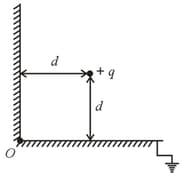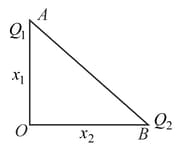The electric force acting between two point charges kept at a certain distance in vacuum is 16N. If the same two charges are kept at the same distance in a medium of dielectric constant 8. The electric force acting between them is _______ N.
Important Questions on Electrostatics
Two charges of equal magnitudes and at a distance exert a force on each other. If the charges are halved and distance between them is doubled, then the new force acting on each charge is
Point charges are placed at the corners respectively of an equilateral triangle . The resultant force on placed at acts:
A charge is situated at a distance '' away from both the sides of a grounded conducting '' shaped sheet as shown in the figure.

The force acting on the charge is
Point charges and are placed in air at a certain distance apart. The magnitude of the force on by is . The magnitude of the force on by is . Then is:
Charges and are at points and of a right-angled triangle . The resultant electric field at point is perpendicular to the hypotenuse, then is proportional to:

